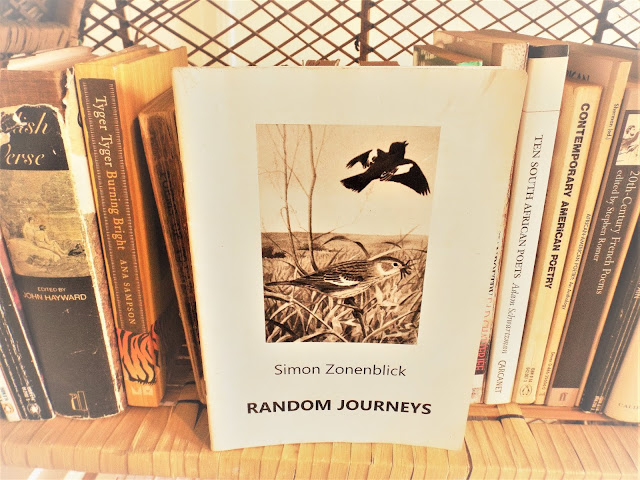Random Journeys poetry pamphlet
Random Journeys, a gathering of twenty one poems written between 2001 and 2014, was published in April 2014 by The Unpretentious Arts, Ripponden. The pamphlet contains poems previously published in Poetry Now, Tears in the Fence, The Black Rose, and also online via both InPossee Review and The Maynard. All for sale copies are now out of stock pending a reprint, but some are still available through libraries.
These poems, begins the blurb, offer reflections on the natural world, rooted in the poet's native Yorkshire. Indeed, most of the poems concern wildlife sightings in and around the edges of West Yorkshire, drawn from childhood memory and contemporary observation, even though they are fairly general in terms of their descriptions - the song thrush summer-plumped and freckle-flecked, might just as easily occupy a tree in London, Lancashire or Llandudno, though set together the poems conjure for me now a tangible memory of the decade or so that I lived in the almost-rural suburb of Oakwood in North Leeds, which is where, often inspired by my daily wanderings among the lakes, streams, hills and woodlands of Roundhay Park, many of these poems were first composed.
Random Journeys begins and ends with birds -
Rising from an algae-thickened lake
crossbow wings clear reeds,
rushes, pools of frogspawn
oiled by the gloss of evening sun
and our feathered friends weave in and out of the pages, be they finches flitting roadside,/ garden,/ motorway, jackdaws shuffling through the spinneys, or many more. I included a poem about swallows, seen at Lizard Point, Cornwall, because watching them one autumn morning thread the mangled crags, / glide above an island's edge, was the first time I had knowingly done so, and the vision of these entrancing birds, arcing through the coastal clouds like gems upon a pebbled shore came to dominate my imagination for a long while. When I moved to the Calder Valley, I was delighted to find that swallows were among the most frequent birds in my vicinity, so the poem seemed an obvious candidate for inclusion.
There are further nods to the world outside of Yorkshire, as in the rugged Goat, a poem which underwent multiple incantations after watching goats beside the motorway where Yorkshire hills rumple into cliffy Cleveland, Grass-gathering, / patrolling the lane / between water and rock, and Deer, written after staying with a friend in Romford, Essex, and taking a solitary morning walk through the verdantly capacious Havering Park, where I came across a herd of reindeer, which lay, or grazed the curving hills / with slow deliberate steps. The fact these deer were essentially confined by the bounds of distant fences caused me some disquiet, but also led to considerations of the nature of confinement and safety, and the extent to which we all live lives, human and animal, defined by fences. It was the morning after David Cameron had been announced as the Leader of the Opposition, mid way through a turbulent decade, and there was a real sense of impending change - for good or ill - which lent an added significance to the meditative calm, like the last moments of reflection before embarking on a new, nerve-racking course of action:
As December frosts
were singed by morning sun
it was like a single moment
The poem speaks of both the gentle interconnectedness of species, as Children held out carrots, / regarded quizzically / by large black eyes, and the distinctly non-human dignity of deer, this blended ballet of muscled bodies.
Elsewhere, the setting is decidedly closer to home - It is to be hoped that the fact the swans' white coats are drizzled with the residue of rain establishes the scene firmly as one of Northern doom and gloom!
The pamphlet is more zoo than anthro centric, though as its title implies, its content is guided by the journeys of its author - though more than once there is a sense of a shifting authorial voice, as in Searching for Badgers, where I paint childhood walks through local woodlands as excursions to the forests. Trees and the cover they provide for both animals and people is a recurrent theme, most evidently touched on in the poem Jedi Houses - one of two pieces to feature Star Wars imagery - which takes its name from the grottoes / holed out of the tangles, / dens of elm or sycamore of a local park, which, as a child, I nicknamed "Jedi Houses," and liked to hide beneath the twig-roofs in secret worlds cut off and dream like:
and all around you in an almost mystical
illumination of the burgundy bark shadows
shoots of moonblue, blood-red,
starry inflorescences, burning jaggedly as lasers,
glinting orbs entwined by briar,
thorn and petioles as sharp as light-sabers.
As such, these poems span a thematic territory both observational and autobiographical - the influence of manmade pasts exemplified by buildings sturdily constructed in the bricks / of bygone eras or standing stones and huge Druidic rock formations, merging with the charts of genealogy of fallen trees, the temporary warmths of nests, and eternities of stone. Taking in moorland walks, kingfishers seen through the slats of bird hides, weasels weaving the tangled thickets of a reedy stream, the pinnacle of slate and gable ends which dominates the hilly hinterlands of Sowerby Bridge, and the convex khaki structures of trees, Random Journeys is my testament to the flora and fauna that foremost in my life during a particular period of time.







Comments
Post a Comment